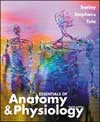 |  Essentials of Anatomy & Physiology, 4/e Rod R. Seeley,
Idaho State University
Philip Tate,
Phoenix College
Trent D. Stephens,
Idaho State University
The Senses
Study OutlineGeneral Senses
Receptors
Types (according to stimulus)Mechanoreceptors
Chemoreceptors
Photoreceptors
Thermoreceptors
Nociceptors
Types associated with the skin(Fig. 9.1, p. 237)Free nerve endings
Pain
Cold and warm receptors
Itch
Movement
Merkel's disks (light touch and superficial pressure)Hair follicle receptors (light touch)Meissner's corpuscles (fine, discriminative touch)Ruffini's end organs (continuous pressure)Pacinian corpuscles (deep pressure, vibration, proprioception) Pain
Types-Sharp and diffuse
Local and general anesthesia
Gate control theory
Referred pain(Fig. 9.2, p. 238)Phantom pain
Special Senses
Olfaction
Anatomy(Fig. 9.3, p. 240)Function
Taste
Taste buds(Fig. 9.4, p. 241)Taste sensations
Vision
Accessory structures(Fig. 9.5, p. 241)Eyebrows
Eyelids
Conjunctiva
Lacrimal apparatus
Extrinsic eye muscles(Fig. 9.6, p. 224) Anatomy of the eye(Fig. 9.7, p. 243)Fibrous tunic
Sclera
Cornea
Vascular tunic
Choroid
Ciliary body
Iris and pupil
Nervous tunic (or retina)(Fig. 9.8, p. 244)Pigmented retina
Sensory retina
Rods-rhodopsin(Fig. 9.9, p. 245)Cones
Macula lutea and fovea centralis (Fig. 9.10, p. 245 - ophtlamoscopic
view) Compartments of the eye
Anterior compartment-aqueous humor
Anterior chamber
Posterior chamber
Posterior compartment-vitreous humor
Functions of the complete eyeClinical Focus: Eye Disordersp.
249-250
Light refraction
Focusing images-accommodation(Fig. 9.11, p. 246) Neuronal pathways(Fig. 9.12, p. 248) Hearing and Balance
The ear and its functions(Fig. 9.13, p. 251)
Clinical Focus: Ear Disordersp. 255
External ear
External auditory meatus
Tympanic membrane
Middle ear
Oval and round window
Auditory (eustachian) tube
Auditory ossicles-malleus,
incus, & stapes
Inner ear(Fig. 9.14, p. 252)Bony labyrinth-perilymph
Membranous labyrinth-endolymph
Cochlear function(Fig. 9.15, p. 252)Steps involved in hearing(Table 9.1, p. 253) Equilibrium
Static equilibrium
Vestibule
Utricle
Saccule
Maculae(Fig. 9.16, Fig. 9.17, p. 254) Kinetic equilibrium
Semicircular canals
Crista ampullaris and cupula(Fig. 9.17, Fig. 9.19, p. 256) |
|



 2002 McGraw-Hill Higher Education
2002 McGraw-Hill Higher Education